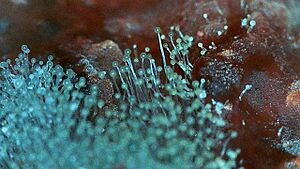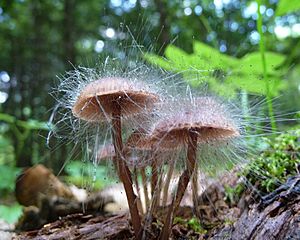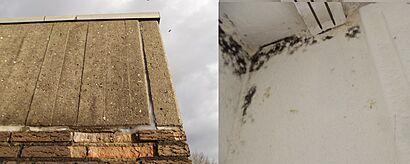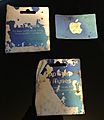Mold facts for kids
Mold is a type of fungus that often looks like fuzzy spots. You might see it on old food or damp surfaces. These fuzzy, colored patches are made of tiny parts called spores. Spores are how mold spreads, much like seeds help plants spread. Not all fungi are molds; some grow as mushrooms, while others are tiny single cells called yeasts.
Molds are a very diverse group of fungi. They grow as a network of tiny, branching threads called hyphae. These threads form a larger network known as a mycelium, which is like the main body of the mold. The fuzzy look of mold comes from these hyphae and the many spores they produce. These spores often have colors, making the mold easy to spot. Molds are microbes, meaning they are tiny living things. They don't fit into one specific family but can be found in different groups of fungi.
Molds help break down natural materials, which can be a problem when they spoil food or damage property. But they are also very useful! Molds help make many foods, drinks, and even antibiotics and other medicines. However, some molds can cause health problems for people and animals. This can happen from allergies to mold spores, from mold growing inside the body, or from harmful substances called mycotoxins that some molds produce.
Contents
What is Mold?
There are thousands of different mold species, and they live in many environments. All molds need moisture to grow. Like all fungi, molds don't make their own food using sunlight (like plants do). Instead, they get energy from the organic matter they live on. Molds release special chemicals called enzymes from their tiny threads. These enzymes break down complex materials like starch and cellulose into simpler substances. The mold then absorbs these simpler nutrients. This process makes molds very important for decomposition, helping to recycle nutrients in ecosystems.
How Molds Grow and Reproduce
Molds reproduce by making huge numbers of tiny spores. These spores can be asexual (made by simple cell division) or sexual (made by combining genetic material). Many molds can make both types. Some spores are light and dry, designed to float in the wind for long distances. Others are slimy and spread by water. Mold spores are often round or oval and can stick to clothes or animal fur. Some spores are tough and can survive very hot or cold conditions.
You usually only see mold when many of its tiny threads (hyphae) grow together to form a large colony. All mold growth happens at the tips of these threads as they spread over or through new food sources. Molds can grow in places like buildings where humidity and temperature are just right. This is why you might see a fuzzy coating of mold on food or other surfaces in your home.
Most molds can't start growing in very cold temperatures, which is why we refrigerate food (usually at 4°C or below). If conditions aren't right for growth, molds can stay alive in a resting state. Different mold species have different tolerances for temperature and humidity. Some molds can even survive in harsh places like the snows of Antarctica or in very acidic liquids. Some special molds, called xerophilic molds, can grow in very dry, salty, or sugary places.
Common Types of Mold
Here are some common types of molds:
- Acremonium
- Alternaria
- Aspergillus
- Cladosporium
- Fusarium
- Mucor
- Penicillium
- Rhizopus
- Stachybotrys
- Trichoderma
- Trichophyton
Molds in Food Production
Molds have been used for centuries to make many different foods, especially in Asia.
- Kōji molds (like Aspergillus oryzae) are used in Eastern Asia to make soybean paste and soy sauce. They also break down starch in rice to make drinks like sake and shōchū.
- Red rice yeast is made from the mold Monascus purpureus grown on rice. It's common in Asian diets and contains substances that can help lower cholesterol.
- Some sausages, like salami, use molds (such as Penicillium nalgiovense) to improve flavor and prevent bad bacteria from growing during curing.
- Molds are also used to make various cheeses (like Brie and Blue cheese), tempeh, and Quorn (a meat substitute).
Molds and Medicine
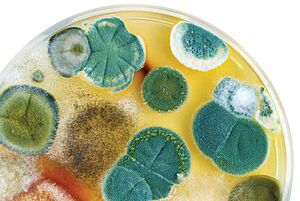
One of the most famous discoveries involving mold was Alexander Fleming's accidental finding of the antibiotic penicillin. In 1928, he noticed that a Penicillium mold stopped bacteria from growing in his lab dishes. This discovery led to the development of penicillin as a medicine.
Later, during the Second World War, scientists like Howard Florey, Ernst Chain, and Norman Heatley at Oxford University worked hard to purify and produce penicillin in large amounts. Their efforts, along with help from the US government and companies like Pfizer, made it possible to create enough penicillin to treat many infections and save countless lives.
Today, molds are still important for medicine. For example, some statin drugs that help lower cholesterol come from molds (like lovastatin from Aspergillus terreus). Also, the medicine cyclosporine, which helps prevent the body from rejecting transplanted organs, comes from the mold Tolypocladium inflatum.
Mold and Your Health
Mold spores are found almost everywhere, including in the dust in our homes and workplaces. While a small amount of mold is usually harmless, large amounts can affect human health.
Some people are sensitive to mold spores and can have allergic reactions. This might include sneezing, a runny nose, red eyes, or skin rashes. Mold can also worsen breathing problems for people with asthma.
Certain molds produce natural toxic compounds called mycotoxins. If people or animals are are exposed to high levels of these mycotoxins, either by breathing them in or eating moldy food, it can make them sick. For example, aflatoxins are mycotoxins that can be found in moldy crops. It's important to avoid eating food that has mold on it. The term "toxic mold" refers to molds that produce these mycotoxins, like Stachybotrys chartarum, but not all molds are "toxic" in this way.
Mold Growth in Homes
Mold often grows in buildings when there's too much moisture. It can colonize porous materials like wood, paper-covered drywall, and insulation. If you see mold growing indoors, it means there's a moisture problem. When mold grows inside, it releases tiny spores into the air. Breathing in a lot of these spores can cause health issues.
Experts can test the air to see if there are more mold spores inside a building than outside. This helps them figure out if mold is growing hidden somewhere.
Preventing Mold in Buildings
The best way to stop mold from growing in your home is to control moisture.
- Reduce humidity: Keep the air inside your home dry. The United States Environmental Protection Agency (EPA) suggests keeping humidity below 60%, ideally between 30% and 50%. Air conditioners can help with this.
- Fix leaks: Repair any leaky pipes, roofs, or windows right away.
- Ventilate: Make sure bathrooms, kitchens, and laundry areas are well-ventilated to remove moisture.
- Clean up spills: Dry wet areas quickly, within 24-48 hours, to prevent mold from starting to grow.
If mold does grow, it's important to clean it up safely and fix the source of the moisture. Sometimes, materials that are heavily molded need to be removed and replaced. If left untreated, mold can cause damage to your home and affect your health.
Related pages
Images for kids
See also
 In Spanish: Moho para niños
In Spanish: Moho para niños


